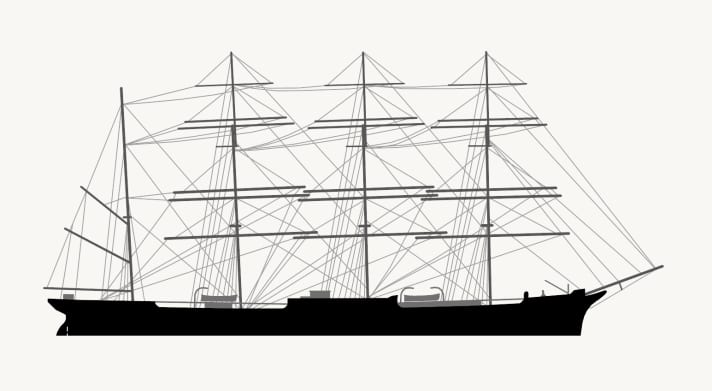





When the age of large cargo-carrying sailing ships came to an end in the 1920s, one man bucked the trend: Gustaf Eriksson. He acquired windjammers that were no longer needed at favourable prices. From then on, these ships sailed under the flag of the Åland Islands. Among them were many former Flying P-Liners of the famous Hamburg shipping company F. Laeisz, such as the four-masted barques "Pommern", "Pamir" and "Passat". "Pamir" and "Passat" were among the so-called "eight sisters", some of which were identical ships from the heyday of F. Laeisz at the beginning of the 20th century.
"Passat" wins the last regatta
In the 1930s, the shrewd businessman Gustaf Eriksson used the sailing ships on the last route on which they were still competitive: the wheat voyage from Australia to Europe. Real regattas took place every year, leading from Australia to Europe via the notorious Cape Horn.
The focus was on fame and honour, but monetary rewards for the fastest crossing also increased motivation. After loading up with wheat in the Spencer Gulf, the race began, which put the ships to the test. The last of these prestigious races took place in 1949 between the "Pamir" and the "Passat", which the "Passat" won. In total, she triumphed four times in this remaining trophy of cargo shipping.
Once again across the South Atlantic
Even when Gustaf Eriksson could no longer operate the ships profitably, their fate was not sealed. Instead of ending up with the scrapper, they were converted into school ships. A dedicated community ensured that the "Passat" was transferred to Travemünde together with the "Pamir".
Thanks to the support of Howaldtswerke in Kiel, the ship was converted into a cargo-carrying sailing training ship, including the installation of a Krupp diesel engine with 900 hp. In 1952, the "Passat" set off on her first voyage as a sail training ship to South America under Captain Hermann Heuer.
Only one sister is lucky
The fact that they were also carrying cargo proved fatal: in 1957, the "Pamir" sank in the South Atlantic when its cargo shifted in a hurricane. 80 sailors lost their lives. The "Passat" narrowly escaped the same fate: in November of the same year, it was caught in a severe storm south-west of the Bay of Biscay on its return voyage from Buenos Aires.
She battled a gale for four days, during which time her cargo of barley began to slide, causing the ship to lean dangerously. However, she managed to avoid capsizing and reached Lisbon. After reloading the barley, the "Passat" continued her voyage to Hamburg, where, having narrowly escaped fate, she was finally decommissioned.
A monument to their era
In 1959, the Hanseatic City of Lübeck acquired the "Passat" and brought her to her current berth on the Priwallufer in Travemünde. She originally served as a training centre for the Schleswig-Holstein Seamen's School. Since 1966, she has been used as a museum and international meeting centre and later as a youth hostel with modern facilities, although original details such as the pigsties on the forecastle have been preserved.
In 1979, members of the Lübeck sports committee founded the Save the Passat" association for the preservation of the ship. While all that remains of the "Pamir" is a broken lifeboat in the Jakobikirche in Lübeck, the "Passat" remains as a living testimony of their time and German maritime history.

Technical data of the "Passat" (1911)
- Four-masted barque, cargo sailing ship
- Shipyard: Blohm+Voss, Hamburg
- Hull material: steel
- Length (overall): 115.0 m
- Height (main mast): 53.1 m
- Sail area: 4,100 m2
- Speed (sails): 17.4 kn
- Berth: Passathafen, Travemünde
Information for visitors
Using diary entries, the exhibition tells the story of the life and work of a ship's boy on the legendary Flying P-Liner. The Travemünde landmark is a museum ship, event venue and accommodation. From April to October, visitors can stay in one of the 102 berths. The association Rettet die Passat e. V. offers guided tours (max. 25 people): 70 euros plus sightseeing fee. E-mail: fuehrungen@rettetdiepassat.de
Opening hours: 01/04 - 04/05 and 29/09 - 31/10 from 11am to 4.30pm; 05/05 - 28/09 from 10am to 5pm.
Prices: Adults: 7 euros, children from 6 to 17 years: 3.50 euros, discount for groups and families, free admission for children under 6 years and holders of the Lübeck holiday pass.
Travelling by boat: Passathafen on the Priwall. Tel.: 0451/ 12287610, mobile: 0151/ 20402479. Information is available on the website of the city of Lübeck. luebeck.de

